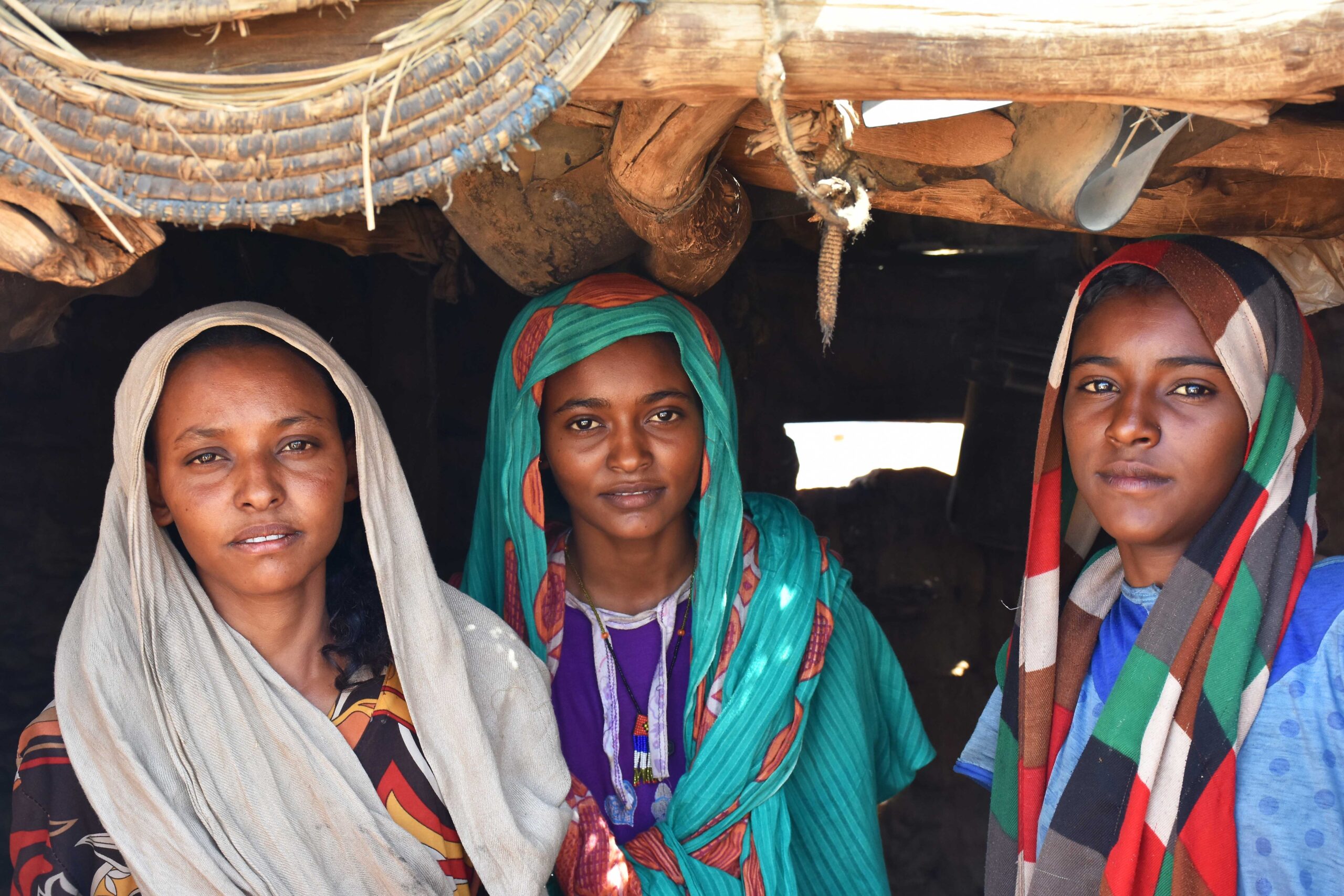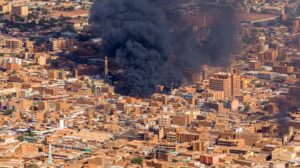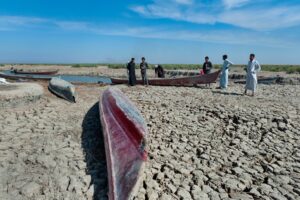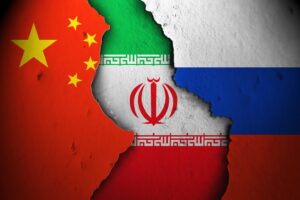Sudan has been plagued by persistent political instability and multiple military coups in recent years, with recent decades of enduring political instability further exasperated by the ousting of President Omar Al-Bashir in the popular uprisings of 2019[i] [ii]. In December 2022, after years of power struggle, Sudanese military forces signed a power-sharing agreement with civilian political elites, seemingly facilitating a transition toward a civilian government[iii]. In April 2023, however, Sudan was once again plunged into unrest as fighting broke out between rival military factions: the Sudanese army, and the Rapid Support Forces (RSF), a para-military force originally created to quell insurgency in the southern Darfur region of Sudan[iv]. Following a tentative week-long ceasefire between 22-29 of May, which was extended by a further five days, fighting between the two factions has re-ignited and is showing no signs of stopping[v].
Reports of Gender Based Violence (GBV) against women across the country are beginning to break through into international news with progressive frequency[vi]. Multiple accounts of rape at the hands of the RSF have been reported[vii], and overall rates of sexual violence across Sudan have increased since the outbreak of the conflict [viii]. Contributing to this hostile environment, according to the World Health Organisation, women across Sudan face extremely limited access to medical services, with as many as 61% of hospitals closing in the capital of Khartoum alone[ix]. Access to medical help is likely to be even more sparse in rural areas. This leaves women with no protection from sexual violence in the first instance, and no access to medical or psychological after-care in the second. Whilst the true number of cases remains unknown due to the lack of reporting, which is characteristic of active conflict zones[x], a full-scale security crisis for women within Sudan is all-but inevitable and must be treated with urgency to prevent further escalation. The international community must act fast to recognise the potential threat to women and implement safeguarding measures in order to avoid a human-security crisis for women and girls in Sudan.
GBV and Rape as a Weapon of War
Rape during periods of war can be deployed strategically as a tool to terrorise local populations and achieve military objectives.
Women are often side-lined in security discussions surrounding warfare and the effects of armed conflict and, traditionally, the security sector does little to recognise and highlight the specific issues which affect women in times of war, including rape and sexual violence, which are defined broadly as Gender Based Violence (GBV)[xi]. Although sometimes overlooked, GBV is a significant security concern as it directly and substantially impacts human security in times of conflict[xii]. In fact, women and children are disproportionately more affected in times of war compared to male civilians[xiii].
According to the UN, rape during periods of war can be deployed strategically as a tool to terrorise local populations and achieve military objectives[xiv]. Although the UN outlawed rape as a war crime as early as 1949, the persecution of rape as a war crime wasn’t enacted until 1998, after the civil war in the former Yugoslavia, where Serbian forces utilised ‘rape camps’ as an instrument of terror[xv]. Previously, rape and sexual violence against women and children were considered an inevitable consequence of war and one of the ‘legitimate spoils of war’ as recently as World War 2.[xvi]
Rape as a consequence of war in modern Middle Eastern and North African conflict can be observed throughout the region, from the devastating sexual violence enacted against women during the Syrian Civil War by both the Syrian regime and ISIS forces.[xvii] There are also examples of rape being used as a tactic of war to secure military gains, as seen between warring tribes in conflict-ridden South Sudan[xviii]. The targeted use of sexual violence as a top-down tool to enforce ethnic domination can be seen in the case of ISIS’s targeted sexual violence toward Yazidi women in Iraq[xix] [xx] [xxi]. Issues of accountability and ineffective rule of law limit the enforcement of safeguarding legislation in the region to prevent of rape and GBV during periods of conflict, resulting in the propagation of dangerous and unstable environments for women. Ranking as the second highest region in the world in terms of rates of sexual violence against women[xxii], women across the Middle East and North Africa have been left physically and psychologically traumatised from these different forms of tactical sexual violence during wartime, forced to shoulder this unspoken cost of war[xxiii].
Sudan and GBV
There are currently no effective national safeguarding measures in place to prevent the mass infliction of Gender-Based Violence by the RSF.
The reports emerging of RSF forces inflicting GBV against the female Sudanese population come as no surprise given the group’s history with the use of rape as a mode of inflicting terror throughout the Darfur region of Sudan[xxiv]. Human Rights Watch’s World Report in 2016 revealed that Sudanese military forces purposefully committed sexual violence against large numbers of women throughout the duration of the Darfur conflict[xxv]. Reports that emerged during this period depicted a savage wave of sexual aggression that inflicted a devastating long-lasting impact on the female population of Sudan[xxvi] [xxvii]. In one particularly shocking instance, RSF forces raped 221 women and girls within a 24hr period in the rural town of Tabit during the conflict[xxviii]. Based on this violent history, the emerging accusations against the RSF in the current conflict in Sudan cannot be ignored. It indicates a re-application of previous war tactics to the current conflict and must be addressed by the international community to avoid allowing another full-scale assault on the lives of Sudanese women at the hands of the group.
In 2020, to address the issue of sexual violence against women in Sudan, and in response to the public outcry surrounding the mass GBV enacted in Darfur[xxix] [xxx], Sudan unveiled their ‘National Strategy of Eliminating Violence against Women 2015-2032’[xxxi]. This was followed a few years later by the ‘National Action Plan for the implementation of UN Security Council Resolution 1325 on Women Peace and Security (2020-2022)’[xxxii]. The introduction of these measures aimed to exemplify to the international audience Sudan’s dedication to the safeguarding of women.
The actual implementation of these measures, however, was limited and largely unsuccessful, with reports citing a lack of community awareness of legal frameworks and limited access to justice as a few of the reasons for the failures of these policies[xxxiii]. In light of the recent political deterioration in Sudan, the instability has led to a deterioration in the rule of law, further limiting the effectiveness of GBV prevention measures across the country. As a result, there are currently no effective national safeguarding measures in place to prevent the mass infliction of GBV by the RSF.
The International Response
[The UN's Action Plan] exemplifies the predominantly reactive, rather than preventative, approach to GBV within the context of Sudan.
On 17th May, the UN called for $3bn in aid globally to tackle the escalating humanitarian crisis in Sudan[xxxiv]. It has also released a revised version of its Sudan Response Plan to re-evaluate the resources necessary to help refugee host countries and the international community to coordinate their response. Over 940,000 people have fled Sudan since April[xxxv]. Chad, Ethiopia, Egypt and South Sudan are the neighbouring countries which have seen the largest influx of Sudanese refugees since the utbreak of fighting[xxxvi] [xxxvii].
The Plan[xxxviii], which covers the 6 months between May-October 2023, pays little attention to the imminent threat of GBV. The matter is raised only twice within the plan, which dedicates one small paragraph on the need to provide Egypt with tools to address the psychological needs of Sudanese refugees who were victims of GBV[xxxix], and outlines the need for healthcare to support survivors of GBV[xl]. This exemplifies the UN’s predominantly reactive, rather than preventative, approach to GBV within the context of Sudan.
According to UNICEF’s recent ‘Humanitarian Situation Report’ on Sudan, there are 4 million people in need of access to GBV risk mitigation, prevention, and response interventions in Sudan[xli]. UNICEF has recorded only 1,207 successful cases of women and girls accessing these resources in 2023, despite a target of 20,953[xlii]. This data shows the failures of existing measures to safeguard women within Sudan. In turn, the efforts to provide support for Sudanese women who enter host countries as refugees have been comparatively more fruitful, due in part to limitations surrounding access and safety for external aid volunteers to operate within Sudanese borders at this time.
Although the African Union has a dedicated framework established for supporting and safeguarding women from GBV in times of conflict[xliii], Sudan was suspended from its membership of the Union in 2019[xliv] and is therefore not protected under the remit of these frameworks. Despite this, the Union has established ‘The Expanded Mechanism on the Sudan Crisis’ and recently hosted its third meeting with representatives from the League of Arab States, the European Union, and the UN Security Council amongst others on the matter[xlv]. These meetings aim to coordinate the aid response, as well as implement the ‘African Union Roadmap for the Resolution of the Conflict in Sudan’[xlvi]. According to the statement released by the African Union, the roadmap outlined six key elements toward the cessation of conflict in Sudan, namely the establishment of a coordination mechanism between regional and global efforts, an immediate and permanent ceasefire, and an effective humanitarian response[xlvii]. The roadmap is not currently accessible to the general public, so it is unknown whether the issue of GBV is being covered in the ongoing talks and to what extent.
Prioritising Women’s Security Moving Forward
When approaching a long-term solution to the issue, a two-pronged approach should be taken.
Looking at similar regional instances of GBV in civil war, as well as drawing from Sudan’s own history, we can deduce that there is a high risk of an imminent GBV crisis in Sudan as a consequence of the current conflict. When approaching a long-term solution to the issue, a two-pronged approach should be taken. One element must address the immediate threats, whilst a second parallel strategy must seek to address the long-standing structural issues which have fostered such an unsafe environment for women in Sudan.
In the immediate future, the crisis must be recognised, pre-empted, and tackled by international organisations such as the UN and the African Union to minimise the long-term psychological and physical damage endured by thousands of Sudanese women at the hands of the warring military forces. The security of women must be prioritised in the ongoing discussions surrounding the international response to the crisis. With new reports of sexual violence against women coming out daily, the focus of aid and support cannot centre primarily on refugees in host countries and must do more to safeguard the women who remain within Sudan.
It is clear that previous efforts to implement safeguarding and reform frameworks to reduce Gender Based Violence in Sudan have been unsuccessful. Moving beyond the current conflict, women must be more actively incorporated and integrated into any new constitutional framework for Sudan, to address these structural issues more effectively at both the societal and political levels. A more effective implementation and monitoring system must also be integrated alongside policy to ensure more far-reaching results. This top-down approach would establish a political environment in Sudan which is more conducive to the safeguarding of women.
As previously noted, Sudan has taken steps to implement pointed legislation aimed at addressing GBV and the protection of women. However, similarly to other countries in the MENA region that have attempted to implement similar legislation, such as (pre-2021) Afghanistan, the legislation’s permeation beyond urban centres leaves much to be desired. Sudanese culture remains staunchly patriarchal, with strict gender roles that position women in an inferior standing within the family structure and wider community[xlviii]. As over 64% of Sudanese citizens live in rural areas, a more hands-on, community-based approach should be implemented, which would work to educate and elevate women’s status within their communities[xlix]. In certain areas such as East Sudan, women make up as much as 80% of the rural population[l]. Prioritising the education and empowerment of women in these communities would encourage a change within these communities from the grassroots. As a result, more funding should be allocated toward community-based and grassroots initiatives which aim to tackle these cultural barriers.
Ultimately, whilst the priority in the short-term must be the immediate aid and safeguarding of Sudanese women caught in the crossfires of the current conflict to prevent a sexual violence crisis, no short-term strategy alone can prevent a similar repetition of history in the future. Gender-Based Violence is a multi-faceted issue, which requires an approach that incorporates both top-down and grassroots initiatives working in unison to facilitate the empowerment of women at both the individual and national levels. A long-term reduction of GBV in Sudan can only be successful if these factors are addressed in parallel.
[i] ReliefWeb. (2023). Sudan: Political Process, Form Transitional Civilian Government, and Shift Disorder Trends – Situation Update (April 2023). Available at: https://reliefweb.int/report/sudan/sudan-political-process-form-transitional-civilian-government-and-shift-disorder-trends-situation-update-april-2023
[ii] Ababa, A. (2022). The Economist. Sudan’s democratic transition is upended by a second coup in two years. Available at: https://www.economist.com/middle-east-and-africa/sudans-democratic-transition-is-upended-by-a-second-coup-in-two-years/21805857
[iii] International Crisis Group. (2023). A Critical Window to Bolster Sudan’s Next Government. Crisis Group. Retrieved from https://www.crisisgroup.org/africa/horn-africa/sudan/critical-window-bolster-sudans-next-government
[iv] Al Jazeera. (2023). Sudan unrest: What is the Rapid Support Forces? Al Jazeera. Retrieved from https://www.aljazeera.com/news/2023/4/16/sudan-unrest-what-is-the-rapid-support-forces
[v] Rickett, O. and Amin, M. (2023). Sudan war enters deadliest phase yet. [Online]. Middle East Eye. Available at: https://www.middleeasteye.net/news/sudan-war-enter-deadliest-phase-yet
[vi] Medlicott, L. (2023). Women at risk of rape, assault and sexual violence on the streets of Sudan. [Online]. iNews. Available at: https://inews.co.uk/news/world/women-risk-rape-assault-sexual-violence-streets-sudan-2343999
[vii] Al Jazeera. (2023). Women speak out online about reports of sexual violence in Sudan. [Online]. Available at: https://www.aljazeera.com/news/2023/5/16/women-speak-out-online-about-reports-of-sexual-violence-in-sudan
[viii] Middle East Monitor. (2023). Sudan: Increased instances of rape lead doctor to post details of measures to take. [Online]. Available at: https://www.middleeastmonitor.com/20230517-sudan-increased-instances-of-rape-lead-doctor-to-post-details-of-measures-to-take/
[ix] World Health Organization. (2023). WHO Director-General’s opening remarks at the media briefing – 26 April 2023. Retrieved from https://www.who.int/director-general/speeches/detail/who-director-general-s-opening-remarks-at-the-media-briefing—26-april-2023
[x] Care (2023) Rapid Gender Analysis Policy Brief: Sudan Conflict Response, May 2023. P. 4. Available at: https://www.careevaluations.org/wp-content/uploads/Sudan-RGA-Brief_May-2023_CARE.pdf
[xi] ActionAid UK. (n.d.). Violence Against Women and Girls (VAWG). Available at: https://www.actionaid.org.uk/our-work/womens-rights/violence-against-women-and-girls-vawg?gad=1&gclid=CjwKCAjwsvujBhAXEiwA_UXnAFvAr7ouhH_woHWyvvNzNeJuIdUvFedPWtSQrOA6xbqe3-jN6vRpKxoC8QsQAvD_BwE
[xii] Human Security Course. (2015). Module 4: Human Security in Diverse Contexts – Issue 1: Gender-based Violence. Retrieved from https://humansecuritycourse.info/module-4-human-security-in-diverse-contexts/issue-1-gender-based-violence/
[xiii] Office of the United Nations High Commissioner for Human Rights (OHCHR). (2022). Women’s Human Rights and Gender-Related Concerns in Situations of Conflict and Instability. Retrieved from https://www.ohchr.org/en/women/womens-human-rights-and-gender-related-concerns-situations-conflict-and-instability
[xiv] United Nations (2014) Sexual Violence: A Tool of War. [PDF] Background Note. Un.org/preventgenocide/Rwanda. P.1. Available at: https://www.un.org/en/preventgenocide/rwanda/assets/pdf/Backgrounder%20Sexual%20Violence%202014.pdf
[xv] The Times. (2022). Rape Is Being Used as a War Crime in Ukraine. [Online]. Available at: https://time.com/6168330/rape-war-crime-russia-ukraine/
[xvi] United Nations (2014) Sexual Violence: A Tool of War. [PDF] Background Note. Un.org/preventgenocide/Rwanda. P.1. Available at: https://www.un.org/en/preventgenocide/rwanda/assets/pdf/Backgrounder%20Sexual%20Violence%202014.pdf
[xvii] Forestier, M. (2017). Rape as a tactic of the Assad Regime. LSE Centre for Women and Security. [PDF]. Available at: https://core.ac.uk/download/pdf/77616043.pdf
[xviii] PBS NewsHour. (2017). Rape used as a weapon in South Sudan’s war. Available at: https://www.pbs.org/newshour/show/rape-used-weapon-south-sudans-war
[xix] Norwegian Refugee Council (2018). Quiet, Cheap and Scarily Efficient: Rape as a Weapon of War. Available at: https://www.nrc.no/shorthand/stories/rape-as-a-weapon-of-war/index.html
[xx] Watson, I. (2014). ‘Treated like cattle: Yazidi women sold, raped and enslaved by ISIS’. CNN.com. Available at: https://edition.cnn.com/2014/10/30/world/meast/isis-female-slaves/
[xxi] Ahmed, H. (2014) The Yezidi Exodus, girls raped by ISIS jump to their death on mount Shingal. Rudaw.com. Available at: https://www.rudaw.net/english/kurdistan/140820142
[xxii] World Bank (2021). MENA must take bold action against gender-based violence (GBV). [Online]. Available at: https://blogs.worldbank.org/arabvoices/mena-must-take-bold-action-against-gender-based-violence-gbv
[xxiii] Amnesty International (2021). MENA: Gender-based violence continues to devastate lives of women across region. [Online]. Available at: https://www.amnesty.org/en/latest/press-release/2021/03/mena-gender-based-violence-continues-to-devastate-lives-of-women-across-region/
[xxiv] Human Rights Watch. (2015). Men With No Mercy: Rapid Support Forces Attacks Against Civilians in Darfur, Sudan. Available at: https://www.hrw.org/report/2015/09/09/men-no-mercy/rapid-support-forces-attacks-against-civilians-darfur-sudan
[xxv] Human Rights Watch. (2016). World Report 2016: Sudan. Available at: https://www.hrw.org/world-report/2016/country-chapters/sudan
[xxvi] Amnesty International USA. (2004). Sudan: Darfur – Rape as a Weapon of War: Sexual Violence and Its Consequences. Available at: https://www.amnestyusa.org/reports/sudan-darfur-rape-as-a-weapon-of-war-sexual-violence-and-its-consequences/
[xxvii] ReliefWeb. (2014). Mass Rape in Darfur: Sudanese Army Attacks against Civilians in Tabit. Available at: https://reliefweb.int/report/sudan/mass-rape-darfur-sudanese-army-attacks-against-civilians-tabit
[xxviii] Aljazeera. (2015). Darfur Mass Rape Termed Crime against Humanity. Aljazeera.com. Available at: https://www.aljazeera.com/news/2015/2/11/darfur-mass-rape-termed-crime-against-humanity
[xxix] Human Rights Watch. (2015). Mass rape in Darfur, Sudan. The Guardian. Available at: https://www.theguardian.com/global-development/2015/feb/11/mass-rape-darfur-sudan-human-rights-watch
[xxx] Sudan Tribune. (n.d.). South Sudan’s sexual violence crisis: How to break the cycle? Sudan Tribune. Available at: https://sudantribune.com/article56134/
[xxxi] UN Women. (2015). National Strategy of Eliminating Violence Against Women 2015-2032. Available at: https://evaw-global-database.unwomen.org/fr/countries/africa/sudan/2015/national-strategy-of-eliminating-violence-against-women-2015-2032
[xxxii] Republic of the Sudan: Ministry of Labour and Social Development (2020) National Action Plan For the implementation of UN Security Council Resolution 1325 on 2020 – 2022. Available at: https://www.un.org/shestandsforpeace/sites/www.un.org.shestandsforpeace/files/sudan-_national_action_plan_2020-2022.pdf
[xxxiii] World Bank (2022). Gender Based Violence (GBV) Assessment Sudan. [Online Document]. P.3-4. Available at: https://www.google.com/search?q=sudan+sexual+violence+action+plan+evaluation&sxsrf=APwXEdc45n8spZFTvkTlQoUQoqXEHxkFrg%3A1686047892715&ei=lAx_ZLmqK5nRgQbIxajwBA&ved=0ahUKEwi5xODtua7_AhWZaMAKHcgiCk4Q4dUDCA8&uact=5&oq=sudan+sexual+violence+action+plan+evaluation&gs_lcp=Cgxnd3Mtd2l6LXNlcnAQAzILCAAQigUQhgMQsANKBAhBGAFQAFgAYO4DaAFwAHgAgAFViAFVkgEBMZgBAMABAcgBAQ&sclient=gws-wiz-serp#:~:text=Gender%2DBased%20Violence,org%20%E2%80%BA%20curated
[xxxiv] UNHCR (2023). UN calls for US$3 billion to rush life-saving aid and protection to people impacted by the Sudan crisis. Africa Renewal. Available at: https://www.un.org/africarenewal/magazine/april-2023/un-calls-us3-billion-rush-life-saving-aid-and-protection-people-impacted-sudan
[xxxv] Middle East Monitor. (2023). 940,000 flee their homes in Sudan. Middle East Monitor. Available at: https://www.middleeastmonitor.com/20230515-940000-flee-their-homes-in-sudan/
[xxxvi] UNHCR (2023) Sudan Emergency Regional Refugee Response Plan. May-October 2023 (Six Months). rep. UNHCR, pp. 1–100. Available at: https://reporting.unhcr.org/document/4838
[xxxvii] Care (2023) Rapid Gender Analysis Policy Brief: Sudan Conflict Response, May 2023. P. 4. Available at: https://www.careevaluations.org/wp-content/uploads/Sudan-RGA-Brief_May-2023_CARE.pdf
[xxxviii]UNHCR (2023) Sudan Emergency Regional Refugee Response Plan. May-October 2023 (Six Months). rep. UNHCR, pp. 1–100. Available at: https://reporting.unhcr.org/document/4838
[xxxix] Ibid. P.54.
[xl] Ibid. P.73.
[xli] UNICEF. (2023). UNICEF Sudan Situation Report. P.11. Available at: https://www.unicef.org/sudan/media/11881/file/UNICEF%20Sudan%20Sitep%20(3%20June%202023).pdf
[xlii] Ibid. P.11.
[xliii] African Union. (2020). Scaling up Actions on Women, Peace, and Security Agenda in Africa. Available at: https://au.int/en/pressreleases/20201109/scaling-actions-women-peace-and-security-agenda-africa
[xliv] African Union. (2023). Sudan Suspended from the African Union. Available at: https://au.int/en/articles/sudan-suspended-african-union
[xlv] African Union. (2023). Third Meeting of the Expanded Mechanism on Sudan Crisis to Discuss Implementation of African Union Roadmap. Available at: https://au.int/en/newsevents/20230531/third-meeting-expanded-mechanism-sudan-crisis-discuss-implementation-african
[xlvi] Ibid.
[xlvii] African Union (2023) ‘Third Meeting of the Expanded Mechanism on the Sudan Crisis to Discuss the Implementation of the African Union Roadmap for the Resolution of the Conflict in Sudan’. AU.int [Preprint]. Available at: https://au.int/sites/default/files/newsevents/mediaadvisories/42813-MA-Media_Announcement_Sudan_30_May_2023_Final.pdf.
[xlviii] Cultural Atlas. (2018). North Sudanese Culture – Family. SBS. Retrieved from https://culturalatlas.sbs.com.au/north-sudanese-culture/north-sudanese-culture-family
[xlix] The Global Economy (2021). Rural population, percent of total population. [Online]. Available at: https://www.theglobaleconomy.com/Sudan/rural_population_percent/#:~:text=Rural%20population%2C%20percent%20of%20total%20population&text=The%20latest%20value%20from%202021,to%20compare%20trends%20over%20time.
[l] International Labour Organization (2013). Africa: Technical cooperation. [Online]. Available at: https://www.ilo.org/africa/technical-cooperation/WCMS_243826/lang–en/index.htm

















